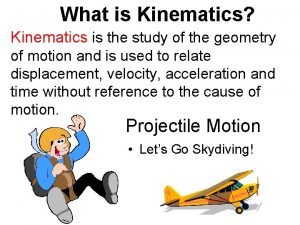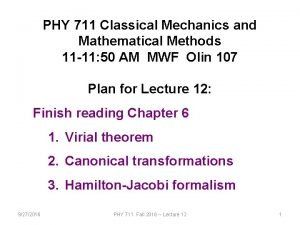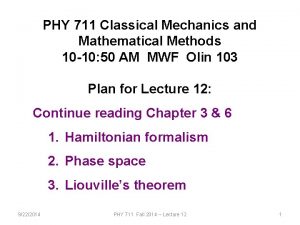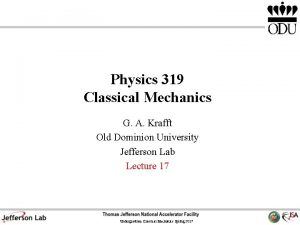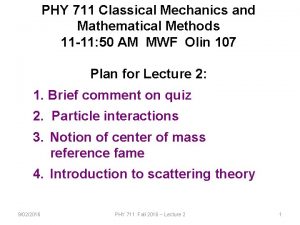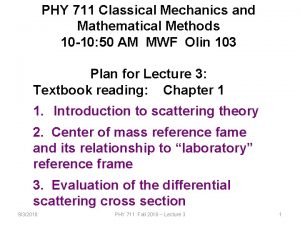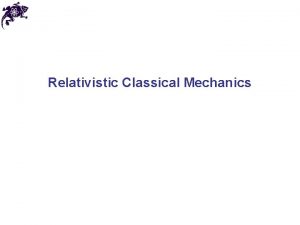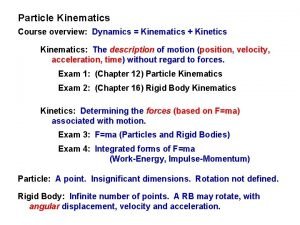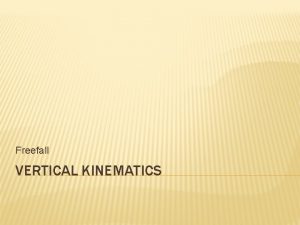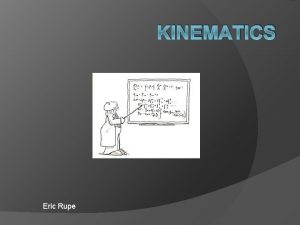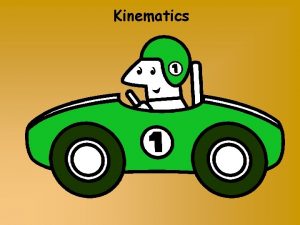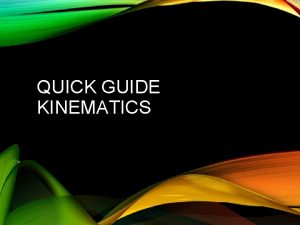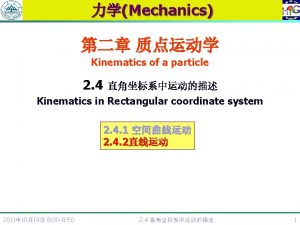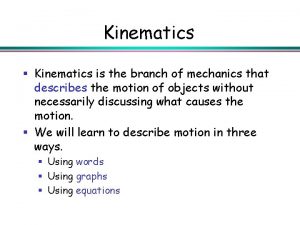Kinematics Classical Mechanics Kinematics Classical Mechanics The study













- Slides: 13

Kinematics

Classical Mechanics Kinematics • Classical Mechanics: – The study of motion related to concepts of force and energy • Kinematics: – Description of how objects move • Dynamics: – Study of forces which cause objects to move

Kinematics – Getting Started • Translational Motion: – Movement without rotation • Motion with a reference frame: – Motion in reference to a set axis Kinematics

Kinematics – Getting Started Kinematics • Scalar - Magnitude only, plus a unit • Vector - Magnitude and direction, plus a unit • Time: t • SI Unit (metric): Seconds (s) • Elapsed time: Δt • Δ Delta (‘change in…’)

Position - Where Kinematics • Where: x, y, or z • Change in Position (Δ…) • Displacement - Shortest straight-line distance between two points Vector SI Unit: meters (m) • Distance - Entire path taken between two points Scalar SI Unit: meters (m)

How Fast? Kinematics • Rate at which the position changes • Average Velocity ( ) displacement time Vector SI Unit: m/s • Average Speed distance Average Speed = time Scalar SI Unit: m/s

Problems with Averages Kinematics • Averages at times don’t tell the entire story • Instantaneous Velocity: velocity measured during an infinitesimally short time interval

Acceleration Kinematics • The rate at which velocity changes • Average acceleration ( • Vector ) SI Unit: m/s 2 • Difference between an acceleration of 3 m/s 2 and 16 m/s 2?

Directions Kinematics • Positive and negative: – Tell DIRECTION, not magnitude • Which is a larger acceleration? -25 m/s 2 or 22 m/s 2

Kinematic Equations Kinematics • Condition: a must be constant • Assumptions: Δt = tf – to = (starting from to of zero) = t xo = starting position (most of the time is also x = 0 m)

Example 1 Kinematics A car goes down a certain road at an average speed of 40 km/h and returns along the same road at an average speed of 60 km/h. Calculate the average speed in km/h for the round trip.

Example 2 Kinematics A car traveling 88. 0 km/h is 110 m behind a truck traveling 75 km/h. How long will it take the car to reach the back of the truck?

Example 3 Kinematics The driver of a car makes an emergency stop by slamming on the car’s brakes and skidding to a stop. How far would the car have skidded if it had been traveling twice as fast initially? (Neglect any reaction time) A. 4 times as far B. The same distance C. 2 times as far D. The mass of the car must be known
 Aplusphysics kinematics-horizontal kinematics
Aplusphysics kinematics-horizontal kinematics Fluid mechanics chapter 4
Fluid mechanics chapter 4 What is kinematics
What is kinematics Virial theorem in classical mechanics
Virial theorem in classical mechanics Virial theorem in classical mechanics
Virial theorem in classical mechanics Define angular momentum
Define angular momentum Classical mechanics
Classical mechanics Classical mechanics
Classical mechanics Classical mechanics
Classical mechanics Classical mechanics
Classical mechanics Classical mechanics
Classical mechanics Classical mechanics equations
Classical mechanics equations Origin of quantum mechanics
Origin of quantum mechanics Classical mechanics
Classical mechanics


